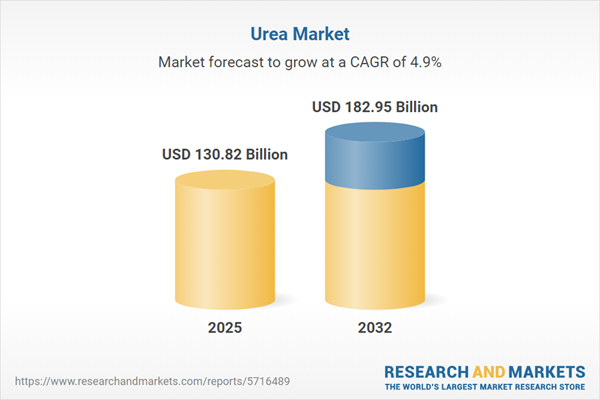Speak directly to the analyst to clarify any post sales queries you may have.
The global urea market is seeing pivotal shifts as leaders seek agile strategies to ensure supply stability, sustainability, and compliance. A complex regulatory landscape and environmental targets now drive decisions from procurement to distribution, shaping resilient operations industry-wide.
Urea Market Snapshot
The urea market demonstrates robust and steady expansion, reinforced by consistent demand in both agriculture and industrial segments. Projected to grow substantially from 2024 to 2032, the sector’s compound annual growth rate underscores urea’s enduring value at the core of global supply chains. As the leading nitrogen fertilizer, it supports productivity, food security, and resource efficiency across agribusiness and chemical manufacturing. Urea’s reach extends beyond the farm, as it is an essential input for plastics, resins, and various industrial products, reducing reliance on single-use sectors and supporting diversified growth. Adoption in emerging markets and continuous investment are stimulated by evolving regulations on food safety, as well as advances in supply network management geared toward mitigating operational complexity.
Scope & Segmentation of the Urea Market
- End Use: Urea plays a major role in cereal and pulse cultivation, is used in diesel exhaust fluid production, supports animal feed formulation, and serves as a feedstock for melamine and urea-formaldehyde resins. Its involvement across agriculture, chemicals, and manufacturing aids in balancing risk exposure across multiple end markets.
- Form: The product is available as granular, prilled, and liquid urea, each form addressing the specific operational requirements of different agricultural and processing settings.
- Application: Urea is utilized in soil enrichment, fertigation, foliar feeding, and precision irrigation, enabling agribusinesses to optimize nutrient management and keep pace with evolving agricultural practices.
- Grade: Available in feed, food, and technical grades, urea meets clearly defined quality and safety needs, supporting compliance and ensuring product continuity.
- Distribution Channel: Organizations manage supply through direct sales, third-party distribution partnerships, and established retail networks, offering essential flexibility and reliability even during market disruptions.
- Production Process: Batch granulation, continuous granulation, and prilling processes support tailored production outcomes, aligning with client specifications and regulatory demands.
- Purity: Standard and high-specialty urea grades are delivered to serve both mainstream and stringent industrial application requirements, expanding access across demanding markets.
- Region: The market spans the Americas, Europe, Asia-Pacific, and Middle East & Africa, with each area featuring unique procurement strategies, regulatory landscapes, and competitive dynamics.
- Key Companies: Industry leadership and innovation are driven by stakeholders such as Nutrien Ltd., CF Industries Holdings, Yara International ASA, EuroChem Group AG, OCI N.V., Qatar Fertiliser Company, Indian Farmers Fertiliser Cooperative, Saudi Basic Industries Corporation, Saudi Arabian Mining Company, and Fertiglobe PJSC.
Key Takeaways for Urea Market Strategists
- Urea’s fundamental role in agriculture and animal production fortifies supply chain resilience as organizations adapt to changing sustainability standards and regulations.
- Manufacturers are adopting renewable hydrogen sourcing and modernized production techniques to reduce emissions, advancing environmental stewardship throughout the sector.
- Integration of precision agriculture tools, such as real-time nutrient tracking and variable-rate application, drives operational efficiency and supports alignment with new benchmarks in farming practices.
- Optimized logistics, underpinned by analytics and automation, strengthens sourcing reliability and delivery predictability, mitigating the risks inherent in volatile markets.
- Enhanced collaboration with technology providers and adoption of circular economy processes increase organizational agility amid evolving regulatory and market structures.
- Heightened risk management and quality assurance protocols ensure stable performance during periods of supply and demand disruption.
Tariff Impact & Evolving Supply Chain Strategies
Revisions to U.S. import tariffs are leading market participants to diversify their sourcing networks and bolster storage capabilities at the regional level. By focusing on local infrastructure and strategic contract management, organizations are reducing exposure to regulatory risk and cost fluctuations while improving supply chain continuity and strengthening partnerships.
Methodology & Data Sources
This analysis is grounded in a combination of thorough secondary research, direct input from key sector participants, and a careful review of relevant regulatory frameworks. Scenario testing ensures actionable insights for executive-level decision-making across all market segments.
Why This Urea Market Report Matters
- Enables executive teams to proactively respond to regulatory changes, pursue growth opportunities, and implement sustainable sourcing strategies in a complex market environment.
- Supports technology adoption, operational improvement, and comprehensive risk management in dynamic procurement landscapes.
- Provides the strategic market intelligence needed for informed investment, partnership, and procurement decisions to support resilience in both global and regional trade contexts.
Conclusion
With these insights, senior leaders can refine decision-making, create sustained value, and maintain strong competitive positioning as the urea market adapts to dynamic global trends.
Additional Product Information:
- Purchase of this report includes 1 year online access with quarterly updates.
- This report can be updated on request. Please contact our Customer Experience team using the Ask a Question widget on our website.
Table of Contents
3. Executive Summary
4. Market Overview
7. Cumulative Impact of Artificial Intelligence 2025
Companies Mentioned
The companies profiled in this Urea market report include:- Nutrien Ltd.
- CF Industries Holdings, Inc.
- Yara International ASA
- EuroChem Group AG
- OCI N.V.
- Qatar Fertiliser Company Q.P.S.C.
- Indian Farmers Fertiliser Cooperative Limited
- Saudi Basic Industries Corporation
- Saudi Arabian Mining Company
- Fertiglobe PJSC
Table Information
| Report Attribute | Details |
|---|---|
| No. of Pages | 186 |
| Published | October 2025 |
| Forecast Period | 2025 - 2032 |
| Estimated Market Value ( USD | $ 130.82 Billion |
| Forecasted Market Value ( USD | $ 182.95 Billion |
| Compound Annual Growth Rate | 4.9% |
| Regions Covered | Global |
| No. of Companies Mentioned | 11 |









